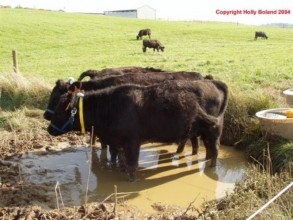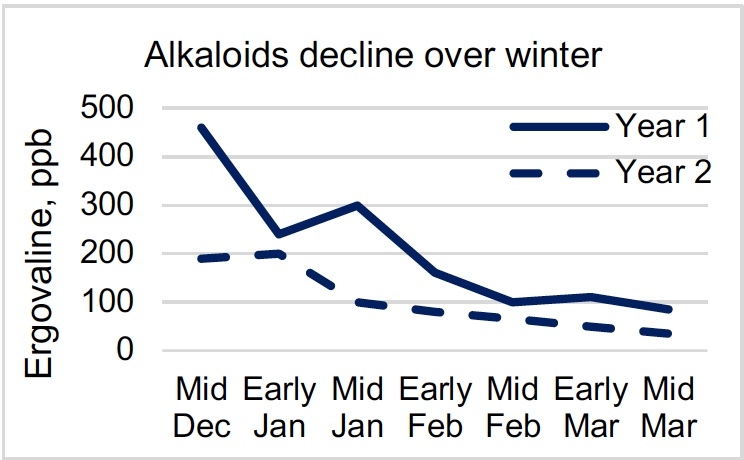Fescue Toxicosis and Some Strategies to Mitigate Alkaloids
ID
SPES-6

Fescue toxicosis occurs as a result of a symbiotic relationship between tall fescue plants and a fungus. This endophyte (meaning “within the plant”) grows between the cells of the fescue plant (figure to left) and produces toxins that support the plant’s survival. Unfortunately, these compounds harm livestock.
Fescue alkaloids Fescue has several classes of alkaloids, but the ones produced by the endophyte and thought to be toxic to cattle are the ergopeptide alkaloids. There is some confusion in the research literature surrounding the toxic levels of alkaloids. This is in part because some researchers have measured “total ergot alkaloids” while others are researching only “ergovaline” (a specific ergot alkaloid) – and there are different ways of making these measures. It also is difficult to quantify the dose an animal is receiving in grazed environments – e.g., alkaloid concentrations vary by plant part, fertility management, weather, etc. and there may be ruminal degradation of these compounds.

Effects on livestock Alkaloids depress prolactin, and in turn reduce milk yield. These compounds also cause constriction of blood vessels. Thus, cattle can’t easily dissipate heat in summer and they can’t easily heat their extremities in winter. That’s why they form wallows or head to surface waters in summer and they can lose ear tips, switches, and even hooves in winter. In the picture to the right, cattle on toxic fescue have formed a wallow simply by splashing water out of their tubs. Note cattle in the background grazing novel endophyte (non-toxic) fescue. Alkaloids also depress reproductive performance.
Threshold toxicity levels Some research suggests that concentrations of ergovaline – probably the primary toxin – may begin to affect animals at levels as low as 150 ppb. (One ppb is like 1 grain of rice in about 925 cups of rice). Ergopeptide alkaloids may make up about ⅓ to ½ of total ergot alkaloids, so in when testing total alkaloids, a threshold of 400 ppb may be closer to causing symptoms in cattle. There appears to be variation among cattle in terms of sensitivity, and the effects of alkaloids typically are more pronounced during times of environmental stress.
Dilution is the solution? This mantra has been used to tell producers to grow legumes or feed supplements along with tall fescue. If it really worked to dilute the toxins, then presumably we could hit some dietary threshold concentration and not see alkaloid symptoms. However, that doesn’t seem to be the case. Rather, the added nutrients in legumes or supplements improve animal performance. This boost in performance is about the same when legumes are added to toxic and to non-toxic pastures. Add legumes – the added nutrition helps performance but it does not eliminate the toxin effects.
Variation in plant alkaloids Fescue alkaloids vary by several factors, including plant part, season, weather, fertility, and harvest management.

The figure above left shows ergot alkaloid concentrations by plant part during spring; the right figure shows average concentration by plant part in response to nitrogen fertility. Note: leaf tissue concentrations relative to seed heads should encourage making hay before it gets too mature.

Alkaloid concentrations often are higher with chemical fertilizers than manures (25% in the case in the above left figure). Alkaloids typically are higher in plant tissues in fall (middle). Ergopeptine alkaloid in this study was >1000 ppb in October (middle figure), although nitrogen rates were at 300 lb./acre. Harvest method also has strong effect on alkaloids (right figure). Fescue was fertilized with 75 lb. N in August and harvested in October. This isn’t typical practice, but it shows that hay (when made in timely fashion), appears the preferred way to conserve tall fescue.
Stockpiling is even better than hay from a nutritional sense, with higher protein and TDN. Stockpile also appears comparable to or better than hay in terms of alkaloids. The data to the left show the decline in ergovaline (not total alkaloid) concentrations from the middle of December for fescue stockpiled with 50lb/acre nitrogen. Fibers increased slightly with little change in protein (12.5-15%).

Virginia Cooperative Extension materials are available for public use, reprint, or citation without further permission, provided the use includes credit to the author and to Virginia Cooperative Extension, Virginia Tech, and Virginia State University.
Virginia Cooperative Extension is a partnership of Virginia Tech, Virginia State University, the U.S. Department of Agriculture (USDA), and local governments, and is an equal opportunity employer. For the full non-discrimination statement, please visit ext.vt.edu/accessibility.
Publication Date
May 3, 2023



